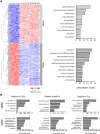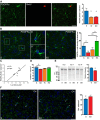Effects of sleep and wake on oligodendrocytes and their precursors
- PMID: 24005282
- PMCID: PMC3874087
- DOI: 10.1523/JNEUROSCI.5102-12.2013
Effects of sleep and wake on oligodendrocytes and their precursors
Abstract
Previous studies of differential gene expression in sleep and wake pooled transcripts from all brain cells and showed that several genes expressed at higher levels during sleep are involved in the synthesis/maintenance of membranes in general and of myelin in particular, a surprising finding given the reported slow turnover of many myelin components. Other studies showed that oligodendrocyte precursor cells (OPCs) are responsible for the formation of new myelin in both the injured and the normal adult brain, and that glutamate released from neurons, via neuron-OPC synapses, can inhibit OPC proliferation and affect their differentiation into myelin-forming oligodendrocytes. Because glutamatergic transmission is higher in wake than in sleep, we asked whether sleep and wake can affect oligodendrocytes and OPCs. Using the translating ribosome affinity purification technology combined with microarray analysis in mice, we obtained a genome-wide profiling of oligodendrocytes after sleep, spontaneous wake, and forced wake (acute sleep deprivation). We found that hundreds of transcripts being translated in oligodendrocytes are differentially expressed in sleep and wake: genes involved in phospholipid synthesis and myelination or promoting OPC proliferation are transcribed preferentially during sleep, while genes implicated in apoptosis, cellular stress response, and OPC differentiation are enriched in wake. We then confirmed through BrdU and other experiments that OPC proliferation doubles during sleep and positively correlates with time spent in REM sleep, whereas OPC differentiation is higher during wake. Thus, OPC proliferation and differentiation are not perfectly matched at any given circadian time but preferentially occur during sleep and wake, respectively.
Figures





Similar articles
-
BMAL1 loss in oligodendroglia contributes to abnormal myelination and sleep.Neuron. 2023 Nov 15;111(22):3604-3618.e11. doi: 10.1016/j.neuron.2023.08.002. Epub 2023 Aug 31. Neuron. 2023. PMID: 37657440 Free PMC article.
-
Temporal and partial inhibition of GLI1 in neural stem cells (NSCs) results in the early maturation of NSC derived oligodendrocytes in vitro.Stem Cell Res Ther. 2019 Aug 27;10(1):272. doi: 10.1186/s13287-019-1374-y. Stem Cell Res Ther. 2019. PMID: 31455382 Free PMC article.
-
Oligodendrocyte precursor cell-intrinsic effect of Rheb1 controls differentiation and mediates mTORC1-dependent myelination in brain.J Neurosci. 2014 Nov 19;34(47):15764-78. doi: 10.1523/JNEUROSCI.2267-14.2014. J Neurosci. 2014. PMID: 25411504 Free PMC article.
-
Physiology of Oligodendroglia.Adv Exp Med Biol. 2019;1175:117-128. doi: 10.1007/978-981-13-9913-8_5. Adv Exp Med Biol. 2019. PMID: 31583586 Review.
-
From precursors to myelinating oligodendrocytes: contribution of intrinsic and extrinsic factors to white matter plasticity in the adult brain.Neuroscience. 2014 Jun 6;269:343-66. doi: 10.1016/j.neuroscience.2014.03.063. Epub 2014 Apr 8. Neuroscience. 2014. PMID: 24721734 Review.
Cited by
-
Sleep and oligodendrocyte functions.Curr Sleep Med Rep. 2015 Mar 1;1(1):20-26. doi: 10.1007/s40675-014-0008-2. Curr Sleep Med Rep. 2015. PMID: 25821717 Free PMC article.
-
REM sleep is associated with white matter integrity in cognitively healthy, older adults.PLoS One. 2020 Jul 9;15(7):e0235395. doi: 10.1371/journal.pone.0235395. eCollection 2020. PLoS One. 2020. PMID: 32645032 Free PMC article.
-
Ontogenesis of the molecular response to sleep loss.bioRxiv [Preprint]. 2023 Jan 18:2023.01.16.524266. doi: 10.1101/2023.01.16.524266. bioRxiv. 2023. Update in: Neurobiol Sleep Circadian Rhythms. 2023 Mar 16;14:100092. doi: 10.1016/j.nbscr.2023.100092. PMID: 36712085 Free PMC article. Updated. Preprint.
-
The genome-wide landscape of DNA methylation and hydroxymethylation in response to sleep deprivation impacts on synaptic plasticity genes.Transl Psychiatry. 2014 Jan 21;4(1):e347. doi: 10.1038/tp.2013.120. Transl Psychiatry. 2014. PMID: 24448209 Free PMC article.
-
Aging Disrupts the Circadian Patterns of Protein Expression in the Murine Hippocampus.Front Aging Neurosci. 2020 Jan 15;11:368. doi: 10.3389/fnagi.2019.00368. eCollection 2019. Front Aging Neurosci. 2020. PMID: 32009941 Free PMC article.
References
-
- Baumann N, Pham-Dinh D. Biology of oligodendrocyte and myelin in the mammalian central nervous system. Physiol Rev. 2001;81:871–927. - PubMed
Publication types
MeSH terms
Substances
LinkOut - more resources
Full Text Sources
Other Literature Sources
Molecular Biology Databases
